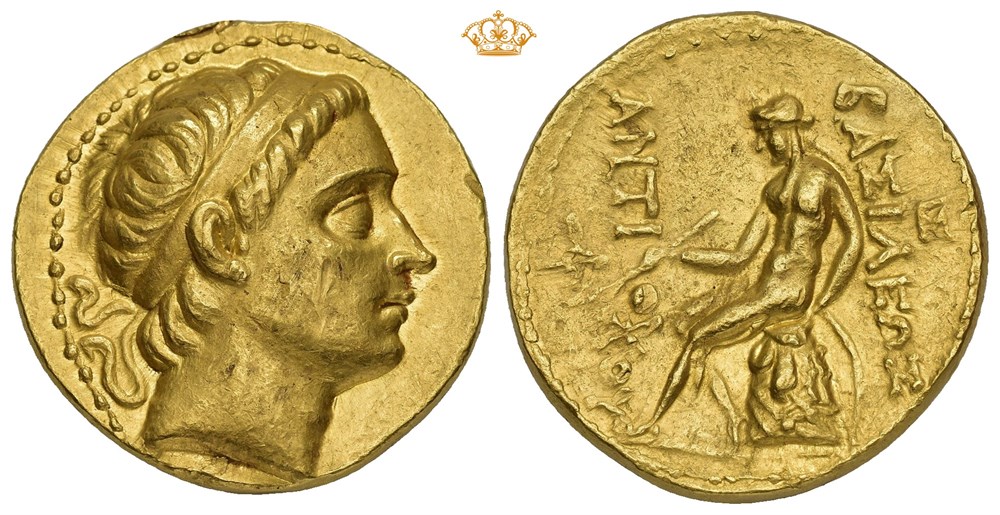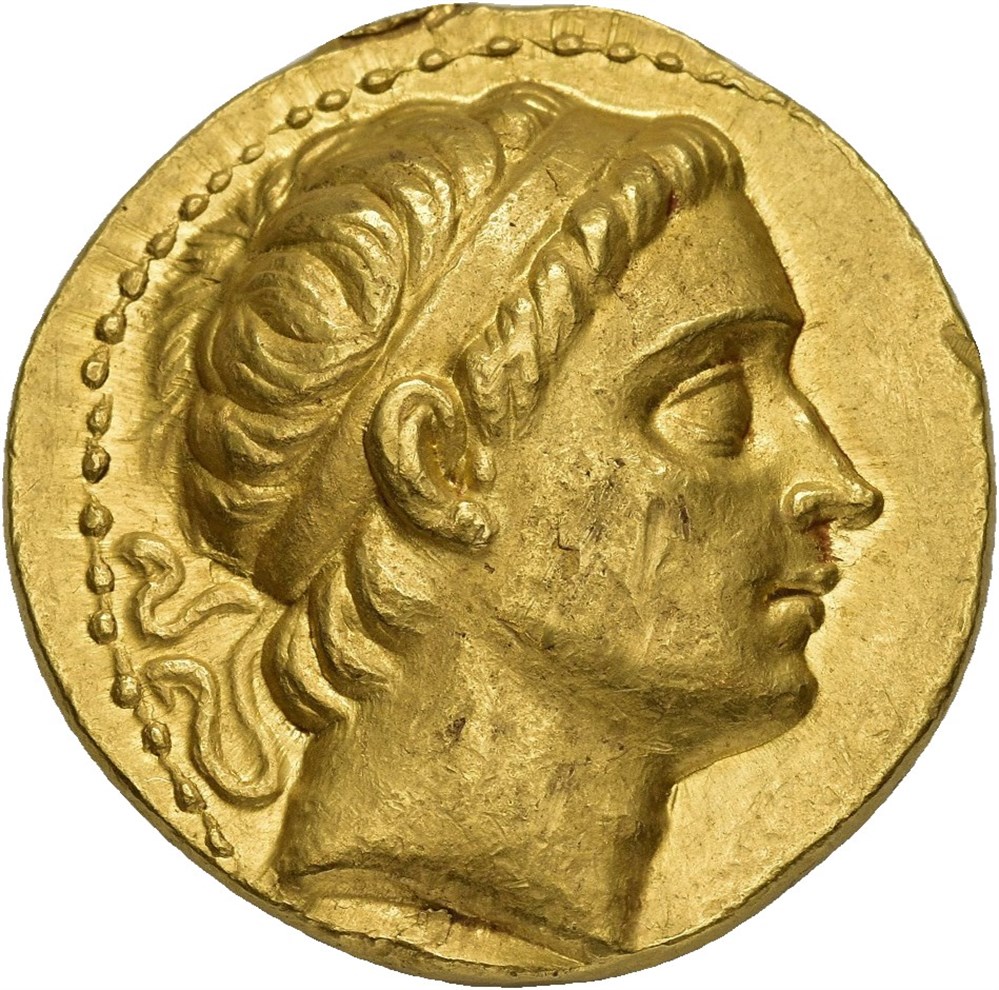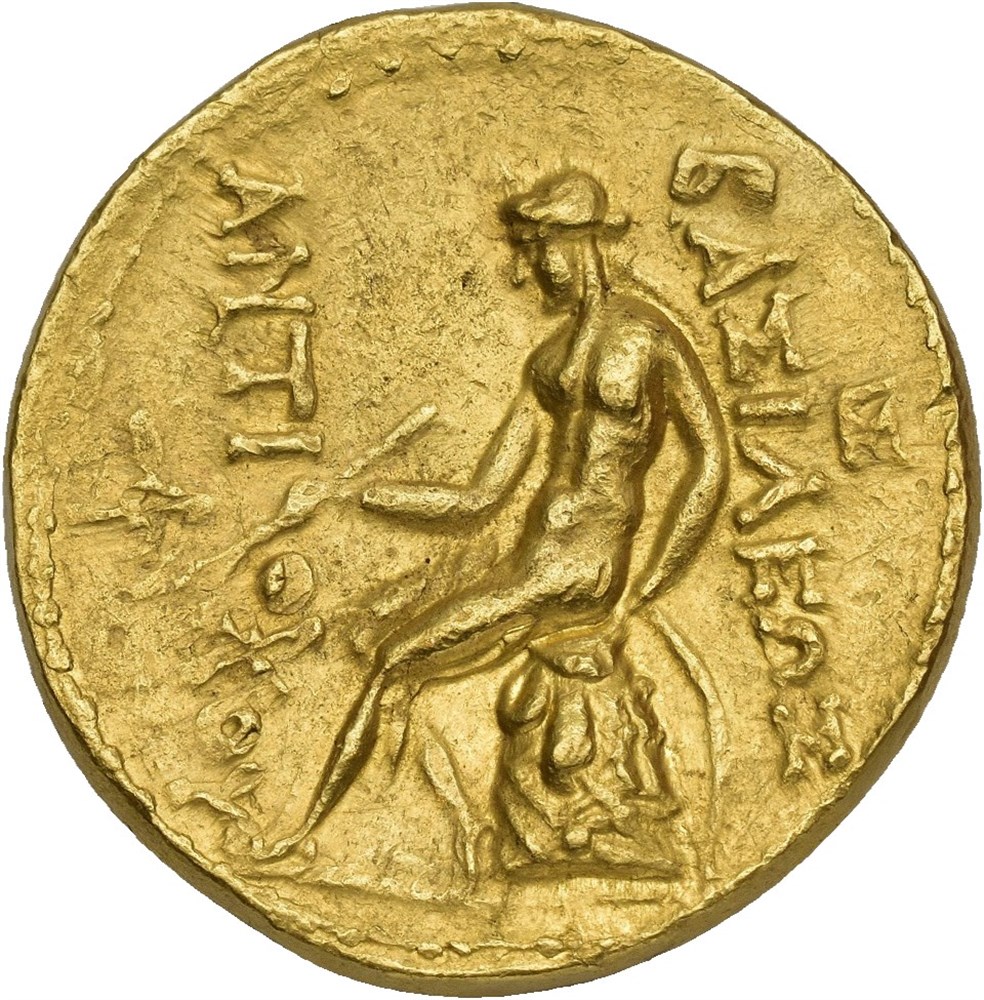- Hjem
- Auksjon 41
- Ancient Coins
- Greek Coins
- Greek Coins
- AV Oktadrachm 197-182 BC (15227731)

Auksjonsreglement (English version further down)
1. Følgende auksjonsbetingelser gjelder for alle budgivere som deltar på auksjonene til Oslo Myntgalleri AS. Ved å avgi bud så forplikter man seg til å følge auksjonsreglement. Auksjonen er offentlig og frivillig. Hvis ikke annet er opplyst vil det være flere innleverere til auksjonen. Objekter merket med en x bak objektnummeret er innlevert av Oslo Myntgalleri AS eller hovedaksjonærene til Oslo Myntgalleri AS.
2. Ethvert bud som blir avgitt er bindende. Budgivere må være myndige, 18 år.
3. Alle auksjonsoppdrag behandles omsorgsfullt, dog er ikke auksjonshuset ansvarlige for mulige feil eller misforståelser som skulle oppstå under auksjonen.
4. Auksjonshuset forbeholder seg retten til å avgjøre om personer får lov til å delta på auksjonen eller ikke. Videre kan auksjonshuset avvise bud, trekke tilbake, omgruppere eller dele objekter. Ved uenighet kan det bli utlyst ny budgivning for én eller flere objekter. Auksjonarius kan selv avgjøre hvem som får tilslaget på et objekt der dette er uklart.
5. Auksjonshuset forbeholder seg retten til å avvise bud fra kjøpere som er ukjente og/eller som ikke har oppgitt tilstrekkelige referanser. Utenlandske kunder og brukere av plattformen for direkte budgivning må registrere seg i god til før auksjonen for å bli vurdert og godkjent som budgivere.
6. Oslo Myntgalleri er pliktig til å utvise nøyaktighet og aktsomhet i beskrivelsen av auksjonsobjektene. Ethvert objekt anses for autentisk og fra perioden som beskrevet hvis det ikke er gitt uttrykk for annet. Disputter vedrørende objekters ekthet vil kun bli behandlet hos The International Bureau for the Suppression of Counterfeit Coins (IBSCC), og en konklusjon fra IBSCC regnes som endelig.
7. Alle objekter selges i den tilstand som beskrevet og fremvist før auksjonsstart. Kjøperne har selv anledning til å besiktige objektene før auksjonen, og eventuelle reklamasjoner som gjelder beskrivelser, merknader og kvalitetsvurderinger, vil ikke bli akseptert etter klubbeslag. Auksjonshusets ansvar er begrenset på samme måte for de som har gitt forhåndsbud eller bud per telefon. Vurderinger gjort av en tredjepart, herunder gradingsselskaper som f.eks. NGC, PCGS og ANACS, vil ikke bli regnet som gyldig reklamasjonsgrunn etter hammerslag.
8. Graderte mynter og sedler: Vi gir ingen garantier for ekthet eller merknader på mynter og sedler som er slabbet i lukkede beholdere og gradert av en tredjepart. Dette gjelder også anmerkninger som er skjult pga. slabben som f.eks. anhengsspor, filemerker ol.
9. Alle forhåndsbud til auksjonen må gis skriftlig og være mottatt auksjonshuset i god tid før auksjonen starter. Forespørsel om budgivning på telefon aksepteres på objekter fra minimumsutrop på 5000 NOK. Avtaler om telefonbudgivning må senest gjøres siste arbeidsdag før auksjonen.
10. Budgivere som byr for andres regning er solidarisk ansvarlig for betaling av kjøpet, hvilket betyr at auksjonshuset kan forholde seg til både budgiver og tredjepart for oppgjør.
11. Alle bud gis i norske kroner og et objekt betraktes solgt til den som har høyeste bud. Ved flere identiske forhåndsbud gjelder budet som først er mottatt av auksjonshuset. I tilfeller med identiske bud fra sal og internettplattformer vil bud fra salen bli prioritert.
12. Prisene i denne katalogen er minstepriser og bud under disse vil ikke bli akseptert. I tillegg til salgssummen tilkommer 20 % salær. Mynter og sedler som har vært gyldig betalingsmiddel er unntatt mva. For medaljer tilkommer 25 % mva på salæret ved levering i Norge. Avgiftspliktige objekter er merket med * ved objektnummeret. Alle forsendelser innenlands skjer med sporbar post og belastes med minimum NOK 200, -. Alle forsendelser til utlandet sendes med DHL eller Fedex (minimumspris i Europa NOK 690,-). Kjøper kan også hente auksjonsobjekter hos auksjonshuset sine kontorer i Oslo og Haugesund. Kjøper står selv ansvarlig for å oppgi riktig adresse for fakturering og forsendelse, og auksjonshuset står ikke ansvarlig for feiladresserte forsendelser som skyldes manglende eller feilaktig informasjon fra kjøper.
13. All betaling må skje i NOK (norske kroner) og kjøpesummen må være godskrevet vår konto senest 7 dager etter at faktura er utstedt. Ved forsinket betaling påløper 1 % rente pr. påbegynt måned. Hvis betaling ikke er godskrevet auksjonshusets konto innen 30 dager etter at auksjonen er avholdt, kan auksjonsobjektet selges for kjøpers regning og risiko. Auksjonshuset bestemmer alene på hvilken måte slikt salg gjennomføres og uten videre meddelelse til den opprinnelige kjøper. Opprinnelig kjøper står derfor selv ansvarlig for ethvert økonomisk tap, herunder tapt provisjon og redusert salgspris. Eventuelle omkostninger i forbindelse med inkasso og videresalg blir også belastet den opprinnelige kjøper.
14. Ved vederlag i kontanter kan vi kun motta beløp inntil kr 39.999 per kunde, jf. Hvitvaskingsloven § 4a.
15. Risikoen for kjøpet går over til kjøper ved klubbeslag, dog går ikke eiendomsretten over til kjøper før kjøpesummen er betalt i sin helhet. Auksjonshuset er ansvarlig for at objektene oppbevares på forsvarlig måte inntil de er fysisk overlevert til kjøper eller fraktfirma. Alle forsendelser skjer på kjøpers regning og risiko, og kjøper må selv sørge for forsikring av forsendelsen. Auksjonshuset er ikke ansvarlig for sendinger sittende fast hos utenlandsk tollvesen, pga. lokale tollregler. Det samme gjelder for sendinger som er nektet mottatt av kjøper.
16. Alle norske mynter preget før 1538, med enkelte unntak, vil ikke kunne eksporteres ut av landet. For budgivere som byr online vil aktuelle objekter med denne restriksjonen være merket.
17. Innleverere får utbetalt hammerslag fratrukket selgerprovisjon cirka 4-6 uker etter auksjonsslutt.
18. Hvis det til tross for dette reglementet skulle reises innsigelser mot auksjonshuset eller innleverer, må slikt gjøres innen 14 dager etter at objektet er utlevert eller mottatt via post. Innsigelser kan ikke gjøres dersom objektet ikke er betalt innen 30 dager etter auksjonsdato.
19. Oslo vedtas som verneting for alle tvister som måtte utspringe fra denne auksjonen eller dette reglementet.
20. Auksjonshuset tar forbehold om at det kan bli foretatt endringer av auksjonsreglementet mellom auksjonene.
Terms and conditions for our auctions
1. The following terms and conditions apply to bidders in all auctions held by Oslo Myntgalleri AS. By making a bid, the bidder agrees to our terms and conditions and accepts to be bound by them. The auction is open to the public and all participation is voluntary. Unless otherwise stated, there will be more than one consignor. Lots marked with an x behind the lot number are consigned by Oslo Myntgalleri AS or by the main shareholders of Oslo Myntgalleri AS.
2. All bids are binding, and bidders must be of legal capacity, i.e. at least 18 years old.
3. Although the auctions are to be conducted with great care, the auctioneer is not responsible for possible mistakes or misunderstandings on the part of the buyer.
4. The auctioneer has the right to deny a person to take part in the auction. He may also withdraw, re-arrange, or divide lots. In case of disagreements during an auction, the auctioneer may restart bidding for or more lots to settle a dispute.
5. The auctioneer may refuse to accept bids from a person unknown or without proper references. Foreign clients should register several days prior to the auction day and give the auctioneer sufficient time for reference check.
6. It is the duty of the auctioneer to give accurate and honest descriptions of all lots. Unless otherwise stated, all lots are guaranteed authentic and from the period as described. Disputes regarding the authenticity of objects will be settled at the International Bureau for the Suppression of Counterfeit Coins (IBSCC). Opinions from the IBSCC will be deemed definitive in cases of authenticity concerns.
7. All lots are sold in the condition as described in the catalogue and shown prior to the auction. All bidders should appraise and inspect the lots prior to the auction. Consequently, complaints about descriptions, remarks and grades will not be accepted after the lots have been sold. This restriction for complaints also applies to absentee bidders. Opinions from third-party grading services (e.g. NGC, PCGS, ANACS etc.) is not a sufficient cause for any returns of purchased items.
8. Graded coins and banknotes: We do not give any guaranty for the authenticity or possible defects on graded coins in slabs and other holders from third party grading companies.
9. Written pre-bids must be delivered to the auctioneer in due time before the auction. Telephone bidding is only accepted for lots with starting prices above NOK 5000, -. All clients must make preliminary agreements with Oslo Myntgalleri at least 24 hours before the auction starts.
10. Agents bidding on behalf of their clients are fully responsible for settling the payment of their purchased lots. The auctioneer may hold both agent and third-party clients responsible for unsettled payments.
11. All bids are given in Norwegian kroner and all lots are sold to the highest bidder. In case of identical bids, the first bid will be prioritized. In case of identical bids from the Room and Internet, the Room bids will be prioritized.
12. The prices in the catalogue are minimum prices and lower bids will not be accepted. A buyer’s premium of 20 % is added to the hammer price of each lot. All coins and banknotes that are or have been legal tender are exempted from VAT in Norway. 25 % VAT is added to the buyer’s premium on medals when picked up in Norway. On medals sold for export, the buyer’s premium is 20 %. Lots that are subjected to VAT is marked with * by the end of the lot number. Domestic shipments are sent with registered mail with tracking at a minimum charge of NOK 200, -. All international shipments will be sent with DHL or Fedex at a minimum price of NOK 690, -. Successful bidders may also to pick up their won lots at our offices in Oslo and Haugesund. Oslo Myntgalleri is not responsible for shipments that are lost due to wrong or insufficient address information provided by the buyer.
13. All payments must be arranged in NOK (Norwegian Kroner). The sale is completed upon receipt of payment, at the latest 7 days after the bidder has received the invoice. In the case of later payment, 1 % interest is added at the beginning of every month. The buyer is responsible for paying all bank charges and shipping and insurance costs. If payment has not been received within 30 days after the auction, the auctioneer reserves the right to sell any unpaid lot(s) if necessary. The auctioneer alone will decide how such sale is conducted and the sale will always be at the risk/cost of the original buyer. Such sales may take place without further notice and the original buyer is responsible for any economic loss due to lost commission or reduced sale price.
14. Payments in cash cannot exceed NOK 39.999,00 pr. customer, ref. Norwegian Anti-Money Laundering Act § 4 a.
15. The property right of purchased lots will pass over to the buyer when the invoice is fully paid. The auctioneer is responsible for a careful and secure storage of all lots until they are picked up by the buyer or a shipping agent. All international shipments are on the risk of the buyer and the buyer is fully responsible for the insurance of items that are in transit. The auctioneer is not responsible for local customs regulations, customs delays, or import VAT issued by authorities in other countries. The auctioneer will not accept any costs related to return-shipments where delivery has been rejected by the recipient.
16. All Norwegian coins made before 1538, with a few exceptions, are not allowed to be exported out of Norway. Items with such restrictions will be marked on our bidding platform.
17. Consignors will be paid approximately 4-6 weeks after the auction.
18. Complaints about the auctioneer or the consignor must be raised in written form within 14 days after the auction. Specific complaints about any sold lots must be raised within 14 days upon delivery. Objections cannot be raised for lots that are not paid within 30 days after the auction.
19. All legal disputes or claims arising out of these terms and conditions shall be governed by and constructed in accordance with the law of Norway.
20. We may amend these terms and conditions from time to time.
Alle forsendelser innenlands skjer med sporbar post og belastes med minimum NOK 200, -. Alle forsendelser til utlandet sendes med DHL eller Fedex (minimumspris i Europa NOK 690,-). Kjøper kan også hente auksjonsobjekter hos auksjonshuset sine kontorer i Oslo og Haugesund. Kjøper står selv ansvarlig for å oppgi riktig adresse for fakturering og forsendelse, og auksjonshuset står ikke ansvarlig for feiladresserte forsendelser som skyldes manglende eller feilaktig informasjon fra kjøper.
Domestic shipments are sent with registered mail with tracking at a minimum charge of NOK 200,-. All international shipments will be sent with DHL or Fedex at a minimum price of NOK 690, -. Successful bidders may also to pick up their won lots at our offices in Oslo and Haugesund. Oslo Myntgalleri is not responsible for shipments that are lost due to wrong or insufficient address information provided by the buyer.
AV Oktadrachm 197-182 BC 
SELEUKID KINGS. Antiochos III 223-187
SELEUKID KINGS. Antiochos III 223-187 BC. AV Oktadrachm (29 mm; 34.14 g). Seleukeia on the Tigris mint, struck circa 197-192 BC. Obverse: Diademed head right of Antiochos right. Reverse: BAΣIΛEΩΣ ANTI-OXOY, Apollo Delphios seated left on omphalos, testing arrow with his right hand and resting left hand on bow set on ground; monograms in outer left and right fields. Minor edge flaw/damage and a few light marks on obverse. Weakly struck on reverse. Bold portrait struck in high relief and some remaining luster in fields. Extremely rare.
SELEUKID KINGS. Antiochos III 223-187 BC. AV Oktadrachm (29 mm; 34.14 g). Seleukeia on the Tigris mint, struck circa 197-192 BC. Obverse: Diademed head right of Antiochos right. Reverse: BAΣIΛEΩΣ ANTI-OXOY, Apollo Delphios seated left on omphalos, testing arrow with his right hand and resting left hand on bow set on ground; monograms in outer left and right fields. Minor edge flaw/damage and a few light marks on obverse. Weakly struck on reverse. Bold portrait struck in high relief and some remaining luster in fields. Extremely rare.
- Startdato:
- Sluttdato:
- Objekt ID: 15227731
- Listing ID #: 15227732


